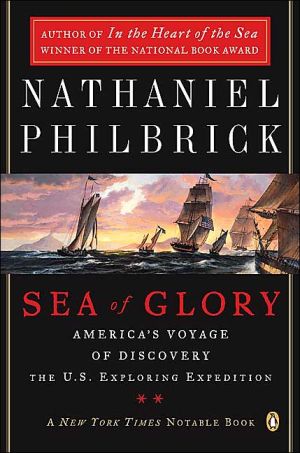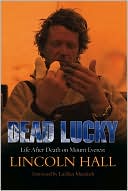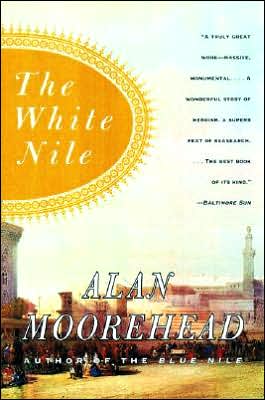Sea of Glory: America's Voyage of Discovery, the U.S. Exploring Expedition, 1838-1842
America's first frontier was not the West; it was the sea-and no one writes more eloquently about that watery wilderness than Nathaniel Philbrick. In his bestselling In the Heart of the Sea Philbrick probed the nightmarish dangers of the vast Pacific. Now, in an epic sea adventure, he writes about one of the most ambitious voyages of discovery the Western world has ever seen-the U.S. Exploring Expedition of 1838? 1842. On a scale that dwarfed the journey of Lewis and Clark, six magnificent...
Search in google:
America's first frontier was not the West; it was the sea—and no one writes more eloquently about that watery wilderness than Nathaniel Philbrick. In his bestselling In the Heart of the Sea Philbrick probed the nightmarish dangers of the vast Pacific. Now, in an epic sea adventure, he writes about one of the most ambitious voyages of discovery the Western world has ever seen—the U.S. Exploring Expedition of 1838— 1842. On a scale that dwarfed the journey of Lewis and Clark, six magnificent sailing vessels and a crew of hundreds set out to map the entire Pacific Ocean—and ended up naming the newly discovered continent of Antarctica, collecting what would become the basis of the Smithsonian Institution, and much more. The New York Times Nathaniel Philbrick's Sea of Glory maintains that Wilkes's arrogance and insecurity even managed to undermine the importance of the expedition's achievements. And Mr. Philbrick provides much evidence of the man's fantastically self-destructive tendencies. While much of this book follows the exploring expedition's exciting and varied adventures, its closing chapters show how the legacy of the Ex. Ex., as it was called, has been obscured. "For more than a century," Mr. Philbrick writes, "Wilkes has stood astride the legacy of the Ex. Ex. like an inscrutable colossus, a forbidding impediment to all who would want to know more." — Janet Maslin
PREFACE\ \ Young Ambition\ He was not yet forty-five, but he looked much older, his health broken by four years of hardship and danger. But he had done it. He had successfully completed the voyage of a lifetime—the kind of voyage that had made heroes of Christopher Columbus and James Cook.\ The odds had been against him from the start. When his squadron of six sailing vessels set out from the Norfolk Navy Yard in 1838, most of the world’s oceans had already been thoroughly explored. That had not prevented the United States from sending him on a bold, some said foolhardy mission: to scour the Southern Hemisphere of the earth for new lands.\ Miraculously, he had made discoveries that would redraw the map of the world. He and his officers had surveyed dozens of uncharted Pacific islands. They had completed America’s first survey of what would one day become the states of Oregon and Washington. His team of scientists had brought back forty tons of specimens and artifacts, including two thousand never-before-identified species. Most impressive of all, he had established the existence of a new continent. Battling icebergs and gale-force winds in his fragile wooden ships, he had charted a 1,500-mile section of Antarctic coast that still bears his name: Wilkes Land.\ But on that September day in 1842, just a few months after his return to the United States, Lieutenant Charles Wilkes was anything but a hero. Instead of being honored with speeches and parades, he had been put on trial in the crowded cabin of the USS North Carolina anchored in New York Harbor. Beside him sat his attorney; across from them were the judges—thirteen naval officers who were about to decide whether he was guilty of illegally whipping his men, massacring the inhabitants of a tiny Fijian island, lying about the discovery of Antarctica, and other outrages. Sitting in the gallery were many of his own officers. They whispered among themselves and smiled, confident that their hated commander would soon get his due.\ He was a slight man with brown hair and a sharp blade of a nose, his cheeks pitted from smallpox and burned red by the sun and wind. Despite his haggard appearance, there was a fierceness in his eyes. After almost three weeks of testimony, it was now time for him to deliver his defense. He cleared his throat, and in a quavering, indignant voice, he began to tell his side of the story.\ America’s first frontier was not the West; it was the sea. The United States began as a string of coastal communities dominated by the Atlantic Ocean—a storm-wracked wilderness that made the forests of the interior look like a beckoning refuge. But travel by road was slow and difficult in the early years of the nation, while the sea was a highway that led to just about anywhere in the world. By the late eighteenth century, American mariners had ventured around Cape Horn to the Pacific. In 1792, a sea otter trader from Boston discovered Oregon’s Columbia River—thirteen years before the arrival of Lewis and Clark. When the United States did finally send an overland expedition beyond the Rockies in 1803, it was to find a navigable waterway to the Pacific. That was why the Lewis and Clark Expedition was called a voyage of discovery. Until the Gold Rush turned the nation’s attention to the winning of the West in 1848, America’s predominant frontier was still the sea.\ A decade earlier, this young nation of sea wanderers became part of an international effort to discover and explore the last unknown portions of the planet. It had begun in 1768, with the voyages of the legendary British navigator James Cook. Earlier explorers such as Columbus and Magellan had been in search of new ways of getting to old, already well-known places—in particular, the spice-rich islands of the East Indies. Their discoveries had been accidental. There had been nothing accidental about Cook’s explorations of the South Pacific. When he returned with reports of palm-fringed islands teeming with people, plants, and animals unlike anything ever seen before, the scientists of Europe clamored for more. In the decades to come, England sent out twenty-eight exploring expeditions to the Pacific; France followed with seventeen, while Spain, Russia, and Holland mounted a total of thirteen voyages among them.\ In spite of all these efforts to probe the islands of the Pacific, there remained a region that had so far resisted scientific inquiry: the ice-studded mystery at the bottom of the world. Cook had ventured below the Antarctic Circle and found nothing but snow and ice. Given the dangerous conditions and the slender prospect of significant results, further exploration hardly seemed warranted. But by 1838 there was renewed interest in the high southern latitudes. What had once been regarded as a forbidding wasteland was now one of the few places left where a discovery of Cook-like proportions might still be possible. Seventy years after the English explorer’s inaugural voyage, the icy waters of Antarctica were just one of the many destinations planned for America’s first oceangoing voyage of discovery.\ They called it the U.S. Ex. Ex., or simply the Ex. Ex., shorthand for the United States South Seas Exploring Expedition of 1838. It was an unprecedented naval operation, especially for a nation with a navy that was less than half the size of Great Britain’s. Whereas most European exploring expeditions comprised two modest-sized ships, the American squadron consisted of six sailing vessels and 346 men, including a team of nine scientists and artists, making it one of the largest voyages of discovery in the history of Western exploration.\ No American or European expedition could compare in size to the flotillas launched by the Chinese emperor Yung-lo in the first half of the fifteenth century, some of which included 27,550 men and ventured as far as the east coast of Africa and perhaps beyond. When China chose to disband her fleets of discovery, Portugal became the world’s leader in exploration. Under the guidance of Prince Henry the Navigator, Portugal developed a new type of vessel called the caravel, specifically designed for exploration. Based on Egyptian and Greek designs and only seventy feet long, with shoal draft to keep from running aground on unknown coasts, the caravel enabled Portugal to become the first European country to round Africa’s Cape of Good Hope and, in 1498, reach the fabled shores of India. By that time, Spain had launched its own expeditions, placing its hopes in an Italian mariner named Christopher Columbus. Columbus insisted that the fastest way to the East was to sail west, and when he subsequently came upon the islands of the Bahamas and the Caribbean, he stubbornly insisted that they were what he had been looking for all along— the Spice Islands of the East Indies. Three hundred and forty-six years later, the history of exploration had come full circle as a nation from the New World Columbus refused to believe existed launched its own voyage of discovery.\ With the U.S. Ex. Ex., America hoped to plant its flag in the world. Literally broadening the nation’s horizons, the Expedition’s ships would cover the Pacific Ocean from top to bottom and bring the United States international renown for its scientific endeavors as well as its bravado. European expeditions had served the cause of both science and empire, providing new lands with which to augment their countries’ already far-flung possessions around the world. The United States, on the other hand, had more than enough unexplored territory within its own borders. Commerce, not colonies, was what the U.S. was after. Besides establishing a stronger diplomatic presence throughout the Pacific, the Expedition sought to provide much-needed charts to American whalers, sealers, and China traders. Decades before America surveyed and mapped its own interior, this government-sponsored voyage of discovery would enable a young, determined nation to take its first tentative steps toward becoming an economic world power.\ The Expedition was to attempt two forays south—one from Cape Horn, the other from Sydney, Australia, during the relatively warm months of January, February, and March. The time in between was to be spent surveying the islands of the South Pacific—particularly the little-known Fiji Group. The Expedition’s other priority was the Pacific Northwest. In the years since Lewis and Clark had ventured to the mouth of the Columbia River, the British and their Hudson’s Bay Company had come to dominate what was known as the Oregon territory. In hopes of laying the basis for the government’s future claim to the region, the Ex. Ex. was to complete the first American survey of the Columbia, and would continue down the coast to California’s San Francisco Bay, then still a part of Mexico. By the conclusion of the voyage— after stops at Manila, Singapore, and the Cape of Good Hope—the Expedition would become the last all- sail naval squadron to circumnavigate the world.\ By any measure, the achievements of the Expedition would be extraordinary. After four years at sea, after losing two ships and twenty-eight officers and men, the Expedition logged 87,000 miles, surveyed 280 Pacific islands, and created 180 charts—some of which were still being used as late as World War II. The Expedition also mapped 800 miles of coastline in the Pacific Northwest and 1,500 miles of the icebound Antarctic coast. Just as important would be its contribution to the rise of science in America. The thousands of specimens and artifacts amassed by the Expedition’s scientists would become the foundation of the collections of the Smithsonian Institution. Indeed, without the Ex. Ex., there might never have been a national museum in Washington, D.C. The U.S. Botanic Garden, the U.S. Hydrographic Office, and the Naval Observatory all owe their existence, in varying degrees, to the Expedition.\ Any one of these accomplishments would have been noteworthy. Taken together, they represent a national achievement on the order of the building of the Transcontinental Railroad and the Panama Canal. But if these wonders of technology and human resolve have become part of America’s legendary past, the U.S. Exploring Expedition has been largely forgotten. To understand why, we must look to the Expedition’s leader and the young officer who began the voyage as his commander’s biggest fan.\ It had taken more than a decade to get the U.S. Ex. Ex. under way. By 1838, years of political infighting had severely damaged the Expedition’s credibility with the American people. But the turmoil made no difference to a twenty-two-year-old naval officer named William Reynolds. Reynolds was a passed midshipman—the pre-Annapolis equivalent of a Naval Academy graduate, who after several years of sea duty and study had passed a rigorous series of examinations. For Reynolds, the U.S. Ex. Ex. was the voyage of his young life, and on October 29, 1838—seventy-two days after the squadron’s departure—he poured out his enthusiasm into the pages of his journal. “And behold! Now a nation which a short time ago was a discovery itself...is taking its place among the enlightened of the world and endeavoring to contribute its mite in the cause of knowledge and research. For this seems the age in which all men’s minds are bent to learn all about the secrets of the world in which they inhabit.” Reynolds then turned his attention to the Expedition’s commander, Charles Wilkes, a controversial choice to lead such an ambitious undertaking. “Captain Wilkes is a man of great talent, perhaps genius,” Reynolds declared. After describing his leader’s extensive scientific and navigational background, he concluded, “In my humble opinion, Captain Wilkes is the most proper man who could have been found in the Navy to conduct this Expedition, and I have every confidence that he will accomplish all that is expected.”\ Months later, after the Expedition had rounded Cape Horn, plunged south into the icy Drake Passage, and surveyed the island paradises of Polynesia, Reynolds would return to this passage in his journal. Over the reference to Wilkes he would scrawl, “great mistake, did not at this time know him.”\ Reynolds would not be alone in changing his opinion of Charles Wilkes. By the end of the voyage, most of the Expedition’s officers had grown to despise their commander. The feelings were mutual. Wilkes would bring charges against several of his officers, who then countered with charges of their own, meaning that what might have been the triumphant return of the U.S. Ex. Ex. became clouded by a series of courts- martial.\ According to common practice, all the Expedition’s officers had been required to keep journals that they were to surrender to their commander at the end of the voyage. Unbeknownst to Wilkes, Reynolds kept two journals: an official log and a secret, far more personal journal that would eventually expand to two volumes and almost 200,000 words. Today these big, twelve-by-twenty-inch unpublished journals reside in the archives of Franklin and Marshall College in Reynolds’s ancestral home of Lancaster, Pennsylvania.\ Sensitive and well-read, Reynolds was a natural writer, and his journals contain some of the best descriptions of the sea to come from a nineteenth-century American’s pen. But the journals are much more than the chronicle of a four-year voyage. Along with the twenty-one letters he wrote to his family back home, the journals tell the story of one man’s coming of age amid the ice floes of the Antarctic, the coral reefs of the South Seas, and the giant pines of the Pacific Northwest.\ At the center of Reynolds’s account is his changing relationship with Wilkes, a relationship that would come to dramatize the tangled legacy of the Expedition. Largely because of its arrogant and uncompromising commander, the Ex. Ex. was never able to shake free of the personal animosities and political intrigue that had plagued it from the start. Even though his journal provides a remarkable window on the Expedition, Reynolds was unable, in the end, to fathom the seemingly inexplicable motivations of his commander. Indeed, for more than a century, Wilkes has stood astride the legacy of the Ex. Ex. like an inscrutable colossus, a forbidding impediment to all who would want to know more.\ But there is a way to see past Wilkes’s rigid professional demeanor. The dozens of letters he wrote to his wife Jane during the long four years of the Ex. Ex. are full of startling revelations. Just a few months into the voyage, Wilkes almost cracked under the pressures of command. What happened to him over the course of the Expedition is part passion play, part object lesson in how the demands of leadership can at once confirm and transform a person’s character.\ By all rights, the Ex. Ex. should have become an enduring source of national pride. But Charles Wilkes was no James Cook. Insecure and egotistical rather than self-effacing and confident, Wilkes had a talent for creating discord and conflict. And yet, there was something quintessentially American about Wilkes and the brash, boisterous, and overreaching expedition that he managed to forge in his own makeshift image.\ Late in life, Mark Twain would remember the excitement he felt when he learned that Wilkes had discovered Antarctica. “When I was a boy of ten, in that village on the Mississippi River which at that time was so incalculably far from any place and is now so near to all places, the name of Wilkes, the explorer, was in everybody’s mouth....What a noise it made, and how wonderful the glory! Wilkes had discovered a new world and was another Columbus....[He] had gone wandering about the globe in his ships and had looked with his own eyes upon its furthest corners, its dreamlands—names and places which existed rather as shadows and rumors than as realities.”\ Henry David Thoreau was also fascinated by the Ex. Ex. “What was the meaning of that South Sea Exploring Expedition,” he wrote in the final chapter of Walden, published in 1854, “with all its parade and expense, but an indirect recognition of the fact that there are continents and seas in the moral world, to which every man is an isthmus or an inlet, yet unexplored by him, but that it is easier to sail many thousand miles through cold and storm and cannibals, in a government ship, with five hundred men and boys to assist one, than it is to explore the private sea, the Atlantic and Pacific Oceans of one’s being alone.”\ In 1851, Herman Melville published Moby-Dick, a novel that includes several references to the U.S. Ex. Ex. More than a decade before, Melville had set out on his own personal voyage of discovery aboard a New Bedford whaleship bound for the very same waters then being plied by the Exploring Expedition. Later, while researching his whaling masterpiece, Melville read Wilkes’s narrative of the voyage with great interest. There he learned how Wilkes mercilessly drove his men beyond the edge of their endurance in search of the icy coast of Antarctica. One literary critic has even argued that Melville based his description of Captain Ahab’s mythic pursuit of the white whale on Wilkes’s search for the white continent.\ Every generation has its great men and women, people who, for whatever reason, feel compelled to push themselves to achieve what others might feel is impossible or not worth the effort. Judged by those standards, Wilkes was a great man. But he was also vain, impulsive, and often cruel. Do his personal flaws negate his greatness? As Melville recognized, they were one and the same. “For all men tragically great,” Melville writes in Moby-Dick, “are made so through a certain morbidness. Be sure of this, O young ambition, all mortal greatness is but disease.”\ For both Wilkes and Reynolds, the Exploring Expedition would be as much a voyage into the private sea described by Thoreau as it would be a voyage around the world. With their help, perhaps we can gain a new appreciation of an undertaking that should be a recognized and valued part of our nation’s heritage. The frontier of Lewis and Clark has long since been civilized out of existence. But as Wilkes and Reynolds came to discover, no one will ever civilize the sea.
Preface: Young AmbitionCh. 1The Great South Sea3Ch. 2The Deplorable Expedition17Ch. 3Most Glorious Hopes43Ch. 4At Sea63Ch. 5The Turning Point87Ch. 6Commodore of the Pacific117Ch. 7Antarctica149Ch. 8A New Continent169Ch. 9The Cannibal Isles189Ch. 10Massacre at Malolo213Ch. 11Mauna Loa233Ch. 12The Wreck of the Peacock259Ch. 13Homeward Bound287Ch. 14Reckoning303Ch. 15This Thing Called Science331Ch. 16Legacy347Epilogue361Notes365Selected Bibliography415Acknowledgments437Index441
\ Library Journal - Booksmack!\ Where to go next from Bryson's wonderful launching pad is a question that could fill a decade with delight. If Richard Fortey's essay on collections caught your fancy, turn next to Philbrick's engrossing account of the voyage that formed the basis of the Smithsonian Institution. Here, amid stories of poor leadership, new lands, and battles, is the tale of a collection gathered, cataloged, and stored. Philbrick has the sensibility of a Royal Society fellow himself, and his book extends Bryson's argument that the world was discovered as much by error as intent. Read it with Fortey's own Dry Storeroom No.1 and Douglas J. Preston's Dinosaurs in the Attic for more detailed looks at how collections are created. Neal Wyatt, "RA Crossroads", Booksmack!, 12/2/10\ \ \ \ \ The New York TimesNathaniel Philbrick's Sea of Glory maintains that Wilkes's arrogance and insecurity even managed to undermine the importance of the expedition's achievements. And Mr. Philbrick provides much evidence of the man's fantastically self-destructive tendencies. While much of this book follows the exploring expedition's exciting and varied adventures, its closing chapters show how the legacy of the Ex. Ex., as it was called, has been obscured. "For more than a century," Mr. Philbrick writes, "Wilkes has stood astride the legacy of the Ex. Ex. like an inscrutable colossus, a forbidding impediment to all who would want to know more." — Janet Maslin\ \ \ Publishers WeeklyAfter chronicling the sinking of the whaleship Essex in In the Heart of the Sea, Philbrick attempts to rescue from obscurity the U.S. Exploring Expedition's 1838-1842 circumnavigation of the world and its cartographic and scientific accomplishments. With a strong narrative pull but an anticlimactic story arc, he chronicles the six-vessel squadron's Pacific escapades. Instead of a grisly page-turner, however, Philbrick follows his bestselling tragedy with a drawn-out success story. More than a tale of the Ex. Ex's journey, the book also profiles the expedition's egomaniacal commander, Lt. Charles Wilkes; the psychological warfare he waged against his officers; and the near-miraculous survival of the squadron despite Wilkes's perverse leadership and lack of nautical experience. Wilkes was, however, an accomplished surveyor, and the Ex. Ex. mapped hundreds of Pacific islands, 800 miles of the Oregon coast, 100 miles of the Columbia River and 1,500 miles of Antarctic coast. The expedition's scientists made groundbreaking contributions in ethnography, biology and geology (their collections formed the basis of the Smithsonian Institution). Particularly noteworthy among Philbrick's gripping passages are his descriptions of brash navigation in the Antarctic-but too much of the book bogs down in Wilkes's petty politicking, as he degraded talented men and promoted incompetent ones so as not to be outshone. After four years at sea, he had alienated nearly every officer and returned home to a court-martial. "Instead of a thrilling tale of discovery and incredible achievement, [America] heard more about the flawed personality of the Expedition's commander than anyone wanted to know," Philbrick writes of Wilkes's 1842 trial, in which he was acquitted. Unfortunately, this spoils the retelling, too. Maps not seen by PW. (On sale Nov. 10) Forecast: Despite a 12-city author tour, national ads and the success of Philbrick's previous National Book Award winner, it's hard to imagine Sea of Glory's subject matter luring as wide an audience as In the Heart of the Sea did. Copyright 2003 Reed Business Information.\ \ \ \ \ Library JournalThe National Book Award-winning author of In the Heart of the Sea returns with another excellent account of maritime history. In 1838, the United States launched a voyage of discovery, with Lt. Charles Wilkes commanding an expedition of six ships and 246 men. The United States South Seas Exploring Expedition (or Ex-Ex, for short) captured the world's attention with its collection of 2000 never-before-identified specimens as well as island surveys, navigational charts used as late as World War II, and the discovery that Antarctica was a continent. Instead of entering the pantheon of discoverers alongside Columbus and Magellan, however, Wilkes returned home, his reputation stained, amid a variety of accusations stemming from his pathological desire to control rather than command. He was court-martialed on a variety of charges, including improperly assuming the rank of commander, killing South Sea islanders, and flogging his men. Found guilty only of the lattermost charge and given a ceremonial slap on the wrist, Wilkes proceeded to press charges against many of his officers. Wilkes is a remarkably complex individual who inspired Melville to create the equally obsessive Captain Ahab. This fascinating tale is based largely on a heretofore undiscovered secret diary kept by one of his officers and other primary sources. Highly recommended for all collections. [Previewed in Prepub Alert, LJ 7/03.]-Daniel Liestman, Florida Gulf Coast Univ. Lib. Svcs., Ft. Myers Copyright 2003 Reed Business Information.\ \ \ \ \ School Library JournalAdult/High School-The author of In the Heart of the Sea: Tragedy of the Whaleship Essex (Viking, 2000) returns with another high-seas adventure: the U.S. Exploring Expedition of 1838-'42 (the Ex-Ex). This "voyage of discovery" was as ambitious, dangerous, and full of promise as the Lewis and Clark Expedition. But while Lewis and Clark have become icons, the name of the Ex-Ex leader, Charles Wilkes, is all but lost from our national consciousness. How this came to be is one central theme. The other is the extensive scientific, political, and nautical legacy of the Ex-Ex. Its lengthy list of accomplishments includes confirmation of a "new continent" (Antarctica); hundreds of new species of plants and animals identified and cataloged; dozens of Pacific islands charted for the first time; and a valid U.S. claim to the Columbia River and Puget Sound region. To garner these triumphs, the officers and crew overcame enormous obstacles, including icebergs, cannibals, and dwindling provisions. This expedition had it all-and one thing more: a commander unable to master his demons. Because of complex circumstances, Wilkes was handed a task beyond his abilities, and he was not given the authority and rank to do it, so he tried to lead by intimidation. Countless things went wrong. It's a miracle most made it back alive, and a greater miracle that they accomplished so much. A riveting read.-Robert Saunderson, Berkeley Public Library, CA Copyright 2004 Reed Business Information.\ \ \ \ \ Kirkus ReviewsThe harrowing survival tale that garnered Philbrick a National Book Award (In the Heart of the Sea, 2000) seems almost a tune-up for this saga of wind and wave. In revisiting the long-forgotten South Seas Exploring Expedition, the author has taken on perhaps the ultimate in fact-based sea stories. Six sailing vessels and 346 men set out in 1838 for a remote region few had ventured. They froze in terror at the bottom of the world, tasted the excess of tropical paradise, slaughtered and were slaughtered by fierce savages in an uncharted archipelago, camped out on the rim of the world's most massive volcano, braved one of the world's most treacherous coastal inlets. Some never returned. The rest lived to spend years contradicting each other's accounts of their voyage. The trust of the US government, a budding but not yet imperial power, was vested in a clearly unqualified officer corps. In charge was Lieutenant Charles Wilkes, a self-made martinet given to doubts, rages, and spasms of paranoia rivaling a Bligh, a Queeg, or any other real or fictional figure who ever trod a quarterdeck. Yet the paradox of Wilkes, as seen by the few friends and many foes whose accounts Philbrick meticulously draws upon, is that he delivered. He discovered Antarctica, named it, and charted its coastline, confirming it as a massive continent. He surveyed hundreds of unsuspected Pacific islands and brought home crates of specimens catalogued by onboard scientists that included thousands of new species of flora and fauna. When the Ex. Ex., as it was known, left these shores, the author points out, "science" in America usually meant a hobby pursued by idle intelligentsia; after Wilkes's squadron (three of sixoriginal ships) returned, and published studies began to pour forth, however, science became a real livelihood. But subsequent internecine squabbling and courts-martial quickly soured the public, relegating both Wilkes and a magnificent venture to oblivion. A rare blend of history, heroics, and gut-gripping emotion. Author tour. Agent: Stuart Krichevsky\ \







